Learn how to make a natural disinfectant spray without rubbing alcohol or vinegar. Instead, this easy recipe can be made with either high-proof vodka or hydrogen peroxide. This versatile cleaning spray can be used to disinfect a variety of household surfaces. Both versions of this recipe contain the required percentages of each ingredient to properly sanitize and combat viruses and bacteria.
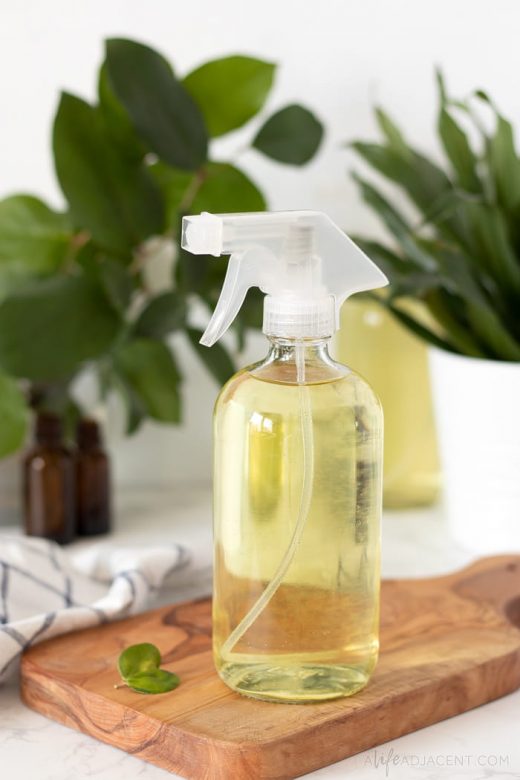
Even before rubbing alcohol was in short supply, we always used high-proof vodka in our homemade cleaning products, including our disinfectant wipes, our window and glass cleaner and our rose petal vodka cleaning spray.
Rubbing alcohol or isopropyl alcohol triggers a migraine in more than one member of our household, so we strived to avoid it whenever possible.
Contrary to some information you may come across, you can use vodka for cleaning and disinfecting. However, with one caveat – it must be high-proof.
So please note that we’re not suggesting that just any bottle of vodka you find on the shelf can be used for this homemade disinfectant spray recipe. More on the brands of vodka that you can use below.
Alternatively, if you don’t have any vodka on hand, or if it’s not easily accessible to you, there is also a version of this disinfecting spray using hydrogen peroxide.
Ingredients for disinfectant spray without rubbing alcohol
Vodka or hydrogen peroxide
To make a disinfectant spray without rubbing alcohol, you can choose between high-proof vodka or hydrogen peroxide.
Vinegar is often a common ingredient in homemade cleaning sprays. However, we made this disinfecting spray without vinegar so that it would be safe for porous surfaces such as granite and marble.
As well, vinegar is not an effective broad spectrum disinfectant, so it should not be used in place of powerful disinfectants such as alcohol, hydrogen peroxide, or bleach.
It’s important to note that you should make the vodka version of this recipe if you’re intending to use it on porous surfaces such as marble or granite countertops. Frequent application of hydrogen peroxide can damage stone countertops.
Essential oils
You can also add a blend of antibacterial essential oils to your recipe. But you can also make this disinfectant spray without essential oils.
The alcohol or hydrogen peroxide are already effective sanitizers on their own so the essential oils are not actually required for disinfecting. However, they do have antibacterial and aromatherapy properties and will leave behind a fresh scent that some people may associate with a clean home.

Spray bottle
If you’re making the version of disinfectant spray with vodka, you can use a clear or amber glass spray bottle for spritzing. However, if you chose to make the spray with hydrogen peroxide, you will need a specialized spray bottle.
Since light decomposes hydrogen peroxide, it needs to be stored it in an opaque bottle to protect it from light. Unfortunately, standard amber glass bottles let in too much light to function as a long term storage option.
The best options are bottles made of ultraviolet glass or opaque brown plastic. You can also use the bottle your peroxide came in and simply replace the cap with a spray nozzle.
If making the spray with vodka, another alternative is to reuse a bottle you may already have on hand. We often reuse this rose water bottle and just add a spray top. It’s a great way to save money and upcycle pre-used bottles.
What kind of vodka should I use for this disinfectant spray?
As mentioned, the alcohol content of the vodka you use for this disinfectant spray recipe is very important.
The brand must be at least 70% alcohol, since this is the minimum required percentage needed for killing a broad range of bacteria and viruses while cleaning. This includes bacteria such as E. coli and lipophilic viruses such as influenza.
Some of the brands that meet the guidelines for high alcohol content include:
- Everclear – 95% alcohol or 190 proof
- Spirytus Rektyfikowany – 96% alcohol or 192 proof
- Devil Springs Vodka – 80% alcohol or 160 proof
- Good ol’ Sailor Vodka – 85% vodka or 175 proof
- Balkan 176 – 88% alcohol or 176 proof
- Pincer Vodka – 88% alcohol or 176 proof
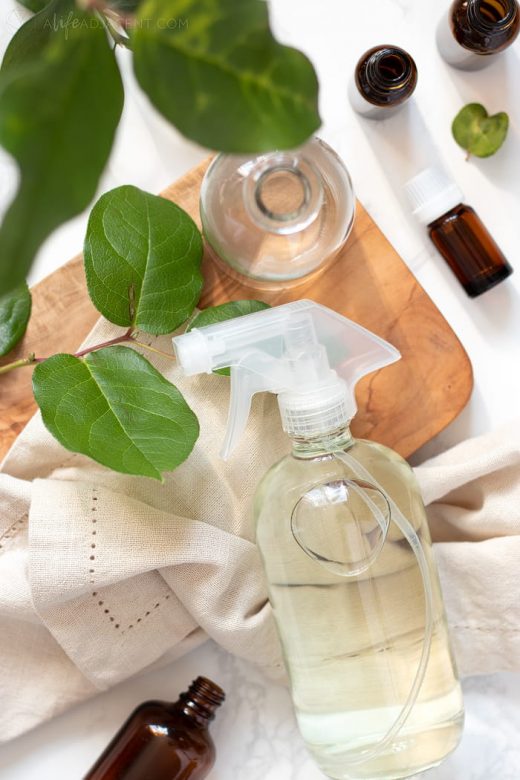
Depending on where you live, other options may be available to you. However, since classifications may vary by country, be sure to double check that the alcohol percentage of each brand to be certain it’s at least 70% alcohol content.
Again, it’s very important to remember that in order for your disinfecting spray to be effective against germs, you must use high-proof vodka or grain alcohol for your recipe. Most vodka is typically only 40% alcohol and therefore will not be effective for household disinfecting.
As well, please remember that witch hazel is not a substitute for alcohol. While commonly touted as a natural alcohol substitute, even the strongest witch hazel extract is only 14% alcohol.
Vodka vs rubbing alcohol for cleaning
In the past, we were hesitant to use rubbing alchohol in our DIYs for a variety of reasons, but desperate times call for desperate measures. So, if you can’t find high-proof vodka then by all means, use rubbing alcohol for this recipe.
However, a homemade cleaning spray containing rubbing alcohol should only be used in a well-ventilated room. Rubbing alcohol (or isopropyl alcohol) has a strong smell and the vapours can cause headaches, dizziness or nausea in some people.
As well, prolonged skin exposure to rubbing alcohol can lead to dryness and eventual cracking, which makes your hands more susceptible to infection. So, if you decide to substitute the high-proof vodka in this recipe for rubbing alcohol, then you will want to don gloves while cleaning to protect your hands.
To learn more about why we strive to avoid rubbing alcohol, we go into more detail about the topic in our post on DIY hand sanitizer.
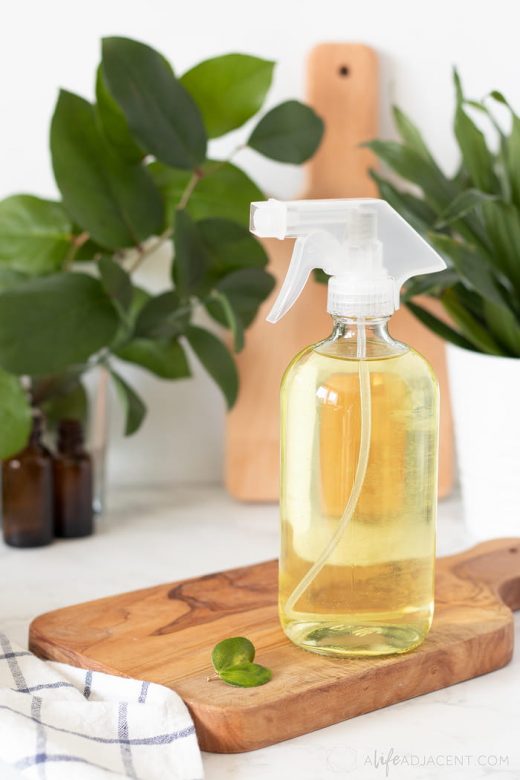
The main point is that any disinfecting cleaning recipe, including our vodka disinfectant spray, must contain vodka or another alcohol product that contains at least 70% alcohol (after all the ingredients are combined).
So if you substitute the vodka for rubbing alcohol, you must use 70% rubbing alcohol.
If you would like to use 99% isopropyl alcohol, you will have to add water to your recipe. While higher concentrations might intuitively seem better, this isn’t always the case when it comes to disinfecting.
99% alcohol does not contain enough water to delay evaporation time, so it evaporates before it has time to fully deactivate germs and viruses.
For more information on diluting 99% alcohol to a 70% solution, see this blog for the formula.
Hydrogen peroxide for disinfecting
We also include a variation of this recipe that includes hydrogen peroxide. So if you’re looking for a disinfecting spray without alcohol, this version might be a good choice.
Hydrogen peroxide (H2O2) is a chemical compound of water and oxygen. It’s a pale blue color but it will appear colorless in water or another solution.
Hydrogen peroxide is a powerful bleaching agent with antibacterial capabilities, and it has a variety of uses both in personal and professional products. Its natural bleaching power and antibacterial properties make it a very effective germ and virus killer.
It’s important to note that you should not mix hydrogen peroxide with vinegar. The result is peracetic acid, which is a respiratory irritant that could also damage your skin and eyes.
Essential oils to use in a disinfectant spray
The following list essential oils have been shown to combat bacteria and household odours. You can pick a combination from this list or use one of the essential oil blend suggestions below.
Antibacterial essential oils for cleaning
- Grapefruit
- Lemon
- Palmarosa
- Cinnamon
- Rosemary
- Bergamot
- Orange
- Clove
- Oregano
- Thyme
- Basil
- Peppermint
- Eucalyptus
- Lemongrass
- Tea tree
One of my favorite essential oils to include in homemade cleaning products is lemongrass. Studies have shown that lemongrass exhibits antimicrobial and anti-bio film activity.
Biofilms are surface-attached micro-organism colonies or accumulations (often bacteria or fungi) that congregate on a variety of surfaces. These colonies form a protective matrix, allowing them to grow rapidly. This rapid bacterial growth can cause serious health problems.

Cinnamon is another powerhouse essential oil that is useful for cleaning. There are a number of studies demonstrating its effectiveness against bacteria, even at its lowest concentration.
But again, it’s important to note that essential oils are only a supplement to the disinfecting properties of alcohol or hydrogen peroxide.
You can make a disinfecting spray with essential oils as long as it contains effective disinfectants like alcohol or hydrogen peroxide. But please do not rely on essential oils as your sole disinfectant, especially during an active virus outbreak.
Essential oils blends for disinfecting
Cinnamon Spice Cleaning Blend
15 drops cinnamon bark essential oil
10 drops clove essential oil
5 drops orange essential oil
5 drops lemon essential oil
Citrus Powerhouse Cleaning Blend
15 drops lemongrass essential oil
10 drops orange essential oil
10 drops grapefruit essential oil
Thieves Cleaning Blend
10 drops clove bud essential oil
10 drops lemon essential oil
5 drops cinnamon bark essential oil
5 drops eucalyptus essential oil
5 drops rosemary essential
How to make disinfectant spray with vodka
For more information and exact measurements, please see the recipe card at the bottom of this post.
- Using a funnel, pour your high-proof vodka into a spray bottle. You can use amber or clear glass spray bottles such as the ones pictured in the photos.
- Next, add the essential oils of your choice, if desired. Since essential oils aren’t required for disinfecting, you can also make this recipe without them.
- Place the lid on your spray bottle and shake to combine.
How to make disinfecting spray with hydrogen peroxide
- Using a funnel, pour your hydrogen peroxide into a dark spray bottle. Since hydrogen peroxide is photosensitive, we recommend screwing a spray nozzle onto the opaque brown bottle the product was packaged in. Alternatively, you can also use a bottle made of dark ultraviolet glass.
- If desired, you can add essential oils. However, this recipe will still be effective without essential oils.
- Place the nozzle onto your spray bottle. Please do not shake your spray – shaking will decompose hydrogen peroxide into water and oxygen, rendering it useless for disinfecting.
How to use your homemade disinfecting spray
Prior to using your disinfectant spray, thoroughly clean the area of any food particles, grease or grime by using a simple combination of soap and water. Any debris left on your surface can affect the disinfecting capabilities of your spray so this is an important step.
Next, spray your disinfecting spray on your surface and allow it to dry. There’s no need to clean the area again as the alcohol or hydrogen peroxide in your spray will evaporate.
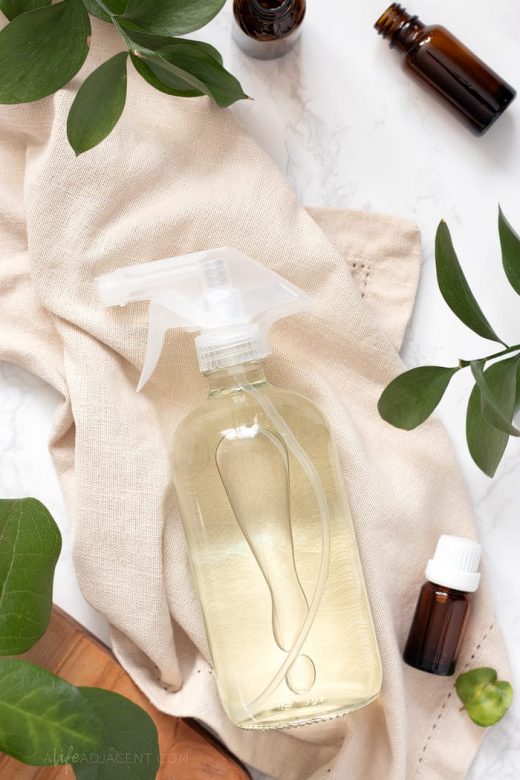
During cold and flu season, you should disinfect the high-touch surfaces of your home daily. These areas will include, but are not limited to — kitchen or dining room tables, kitchen and bathroom counter tops, sinks, faucets, cupboard and drawer handles, light switches, doorknobs, telephones or cell phones, remote controls, keyboards, and toilets.
However, before using your disinfectant spray on a specific area, make sure your surface is compatible with either alcohol or peroxide.
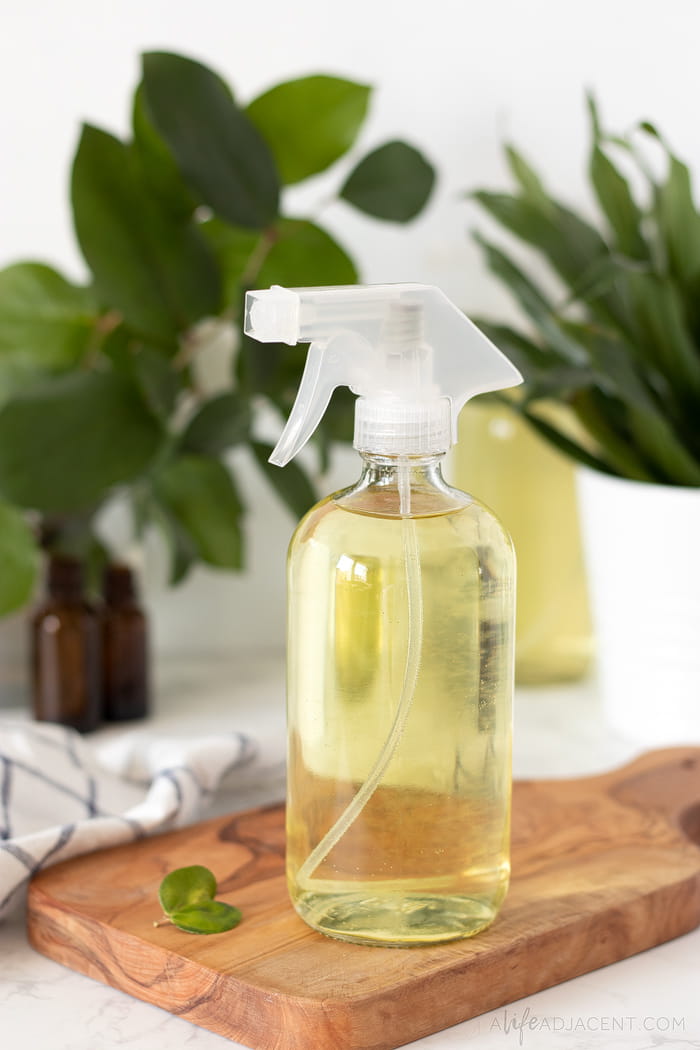
DIY Disinfectant Spray without Rubbing Alcohol
Learn how to make a natural DIY disinfectant spray without rubbing alcohol or vinegar. Make this recipe 2 ways: with hydrogen peroxide or with alcohol from high-proof vodka. Both versions of this recipe contain the required percentages of each ingredient to properly sanitize and combat viruses and bacteria.
Materials
Disinfectant Spray with Vodka
- 2 cups / 500ml or 16 oz high-proof alcohol (see notes)
- 20 drops lemongrass essential oil
- 10 drops eucalyptus essential oil
- 10 drops tea tree essential oil
Disinfectant Spray with Hydrogen Peroxide
- 2 cups / 500ml or 16 oz hydrogen peroxide
- 20 drops lemongrass essential oil
- 10 drops eucalyptus essential oil
- 10 drops tea tree essential oil
Tools
- Clear or amber glass spray bottle (for vodka spray)
- Ultraviolet glass bottle or brown opaque bottle (for peroxide spray)
- Spray nozzle that fits your bottle
Instructions
- Measure the vodka or hydrogen peroxide. Then, use a funnel to pour it into your spray bottle.
- Add your essential oils, if desired. (Since they aren't required for disinfecting, you can make this recipe without essential oils.)
- If making the vodka disinfecting spray, you can shake the bottle to incorporate the essential oils. However, shaking will decompose hydrogen peroxide into water and oxygen, rendering it useless for disinfecting. So if making the version with peroxide, please do not shake your bottle.
- Spritz generously on surfaces and allow it to dry.
Notes
- As mentioned, the alcohol content of the vodka you use for this recipe is very important. For more information, please see this article’s section on vodka brands.
- As always, store this spray and all cleaning products out of the reach of children and pets.
- Due to the high concentration of alcohol, the shelf life of the vodka spray is indefinite but the essential oils may lose their potency over time.
- Hydrogen peroxide is good for 6 months after opening, after which it loses its efficacy. If making the peroxide version, use it within 6 months for best results.
- If you can’t find high-proof vodka then by all means, use rubbing alcohol for this recipe. But please be sure to take proper safety precautions, including using it in a well-ventilated area and avoiding inhaling its fumes.
Recommended Products
As an Amazon Associate and member of other affiliate programs, we earn from qualifying purchases.
More natural cleaning and disinfecting recipes
Looking for more natural and non-toxic cleaning recipes? You may also enjoy:
- Homemade Hand Sanitizer with Vodka
- DIY Disinfectant Wipes with Essential Oils
- DIY All Purpose Cleaner with Vodka
- Air Freshener Jars with Essential Oils
- Homemade Liquid Soap from Bar Soap
- DIY Glass Cleaner without Rubbing Alcohol
For even more natural DIY bath and body ideas, follow us on Pinterest! You can also find us on Instagram, Facebook, and Twitter.
Pin it for later
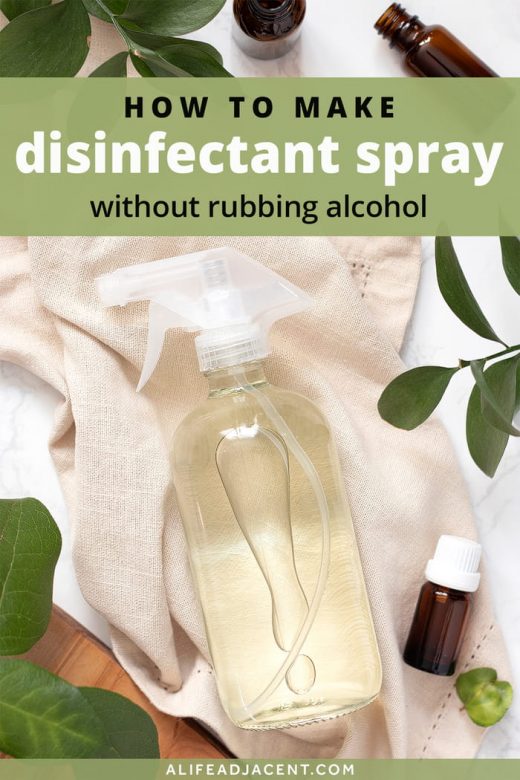








Pat
Monday 13th of April 2020
you say "keep out of reach of pets" - I have been cleaning areas (alcohol/bleach) where my cats walk (they jump on every surface) when they are sleeping and then wash the area with soap and water after about an hour (I don't want any residue to get on their paws which they lick) - if I use Vodka/H2O2 - would I still need to wash the surface with soap and water after using either of these
Kim
Wednesday 15th of April 2020
Hi Pat, H202 is toxic to cats, so yes, I would still wash the area after disinfecting. As for the vodka spray, it's likely safer but I would check with your vet before trying it. I think it's best to err on the side of caution. Stay safe!
Irena
Friday 10th of April 2020
Great idea! I appreciate the in-depth explanation of each ingredient and the different essential oil blends. Stay safe, ladies!
Kim
Saturday 11th of April 2020
Thanks so much, Irena. We hope you ladies are staying safe too!
Michelle
Friday 10th of April 2020
Thank you for this recipe! I can't get any rubbing alcohol and I just ordered some oils. Now I need to put on my mask and head to the liquor store!
Kim
Friday 10th of April 2020
You're welcome, Michelle! Be safe out there!
Cyna
Friday 10th of April 2020
What a useful recipe to have right now - thank you for sharing, Kim!
Kim
Friday 10th of April 2020
Thanks for reading and commenting, Cyna!